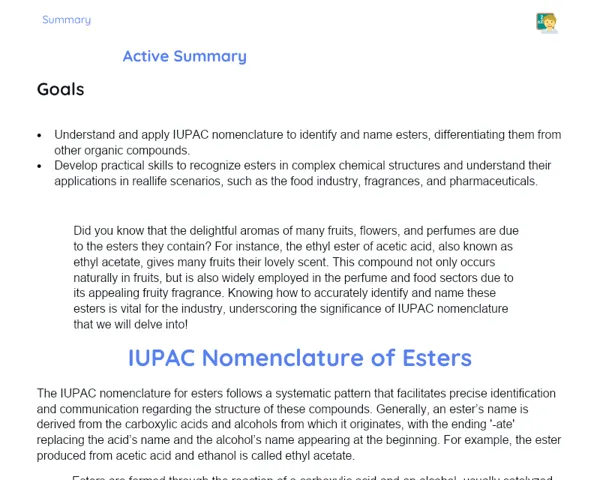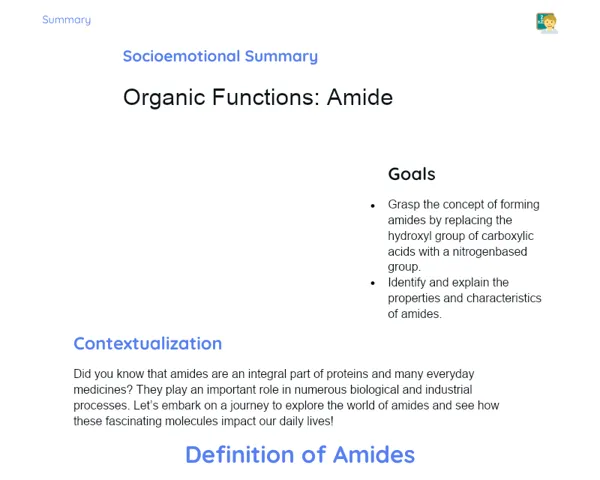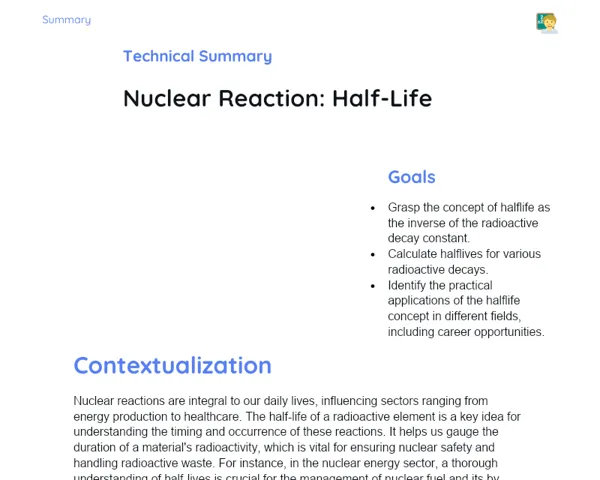Objectives
1. Grasp the concept of molar mass and its significance in chemistry, particularly how it links the mass of a substance with the number of moles.
2. Learn to calculate the mass of a given quantity of a substance from its molar mass, and apply these methods in both practical and theoretical problems.
Contextualization
Did you know that molar mass is a vital tool not only in research labs but also in industries like pharmaceuticals and food processing? For example, when formulating a new medicine, scientists must accurately compute the molar mass of each ingredient to ensure that the dosage is both safe and effective. Similarly, in the food industry, molar mass calculations help determine the precise amount of preservatives required to guarantee the quality and safety of products. Such practical examples underscore the importance and relevance of understanding molar mass in many everyday contexts.
Important Topics
Molar Mass
The molar mass of an element or compound is the mass of one mole of atoms or molecules. It is expressed in grams per mole and is key to converting between mass and the amount of substance. For an element, its molar mass comes from its atomic mass—data you can easily find on the periodic table. In the case of compounds, the molar mass is the sum of the atomic masses of all the atoms in the chemical formula.
-
Essential for various calculations in chemistry, molar mass helps in converting the mass of a substance into moles and vice versa.
-
Aids in formulating chemical reactions and performing stoichiometric calculations, ensuring the proportions of substances are just right.
-
Extremely important in industries, especially in pharmaceuticals and food, to maintain the safety and effectiveness of the products.
Number of Moles
The number of moles is a unit that measures the amount of a substance. One mole is defined as the amount of substance that contains as many elementary entities (atoms, molecules, ions, etc.) as there are in exactly 12 grams of carbon-12. Avogadro's number, approximately 6.022 x 10^23, plays a key role in understanding this concept.
-
Fundamental for stoichiometric calculations and chemical reactions, helping predict both the amounts of products formed and the reagents required.
-
Provides insight into both the macroscopic and microscopic worlds, bridging the gap between mass and the number of particles.
-
Crucial in research and industrial settings, including quality control and large-scale production of chemicals.
Relationship Between Molar Mass and Number of Moles
The link between molar mass and the number of moles is represented by the formula n = m/M, where 'n' stands for the number of moles, 'm' for the mass of the substance, and 'M' for its molar mass. This equation is key to converting between mass and the amount of substance, and is widely used in various fields of chemistry, from analysis to synthesis.
-
Enables the conversion between mass and the amount of substance, a fundamental skill in both laboratory work and industrial applications.
-
Helps in calculating the necessary amounts of reagents in chemical reactions, thereby contributing to efficiency and savings in resources.
-
Essential for understanding and implementing concepts like dilution, concentration, and dosage in disciplines such as pharmacology and biology.
Key Terms
-
Molar Mass - The mass of one mole of a substance, expressed in grams per mole.
-
Number of Moles - A measure expressing the amount of substance in terms of moles.
-
Theoretical and Practical Relationship - Applying the theoretical principles of molar mass and moles to everyday calculations in both laboratory and industrial settings.
For Reflection
-
How does understanding molar mass contribute to ensuring safety and efficiency in the manufacturing of medicines?
-
In what ways can the skill of calculating moles be applied in everyday scenarios beyond the laboratory?
-
Why is it crucial for chemists to comprehend the relationship between molar mass and the number of moles, particularly regarding the economy and efficiency of industrial processes?
Important Conclusions
-
We revisited the concept of molar mass and its vital role in chemistry, especially its connection with the number of moles. We learnt to compute the mass from molar mass and vice versa, applying these methods in both theoretical and practical problems.
-
We examined the practical importance of molar mass across various sectors, from medicine to food production, which highlights its role in ensuring product safety and effectiveness.
-
We discussed how an understanding of molar mass and the number of moles is fundamental for handling quantities in chemical reactions, lab experiments, and industrial processes, thereby proving the real-world applicability of these concepts.
To Exercise Knowledge
- Molecule Calculator at Home: Pick a common household item that contains a chemical compound. Calculate its molar mass and estimate the number of moles present in the item. 2. Molar Mass Diary: Over the course of a week, note down three instances where molar mass finds practical application, for example in food packaging or when reading about medicines. 3. Chemical Kitchen Experiment: Follow a recipe that requires precise measurements of ingredients and calculate the number of moles for each ingredient, applying the concept of molar mass.
Challenge
Create a 3-minute video explaining the importance of molar mass in a specific industry, such as cosmetics or plastic manufacturing. Use practical examples to show how a clear understanding of molar mass can improve both processes and products in that field.
Study Tips
-
Use educational apps and reputable websites to practice molar mass and mole calculations. Many online resources offer interactive exercises that can help reinforce your understanding.
-
Teach the concept of molar mass to a friend or family member. Explaining it to someone else is a great way to reinforce your own learning.
-
Keep a dedicated chemistry notebook to jot down notes on molar mass, number of moles, and their applications, and to record questions that can be discussed in class.



